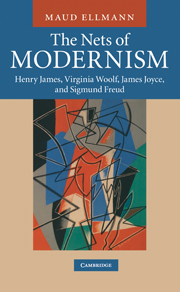Book contents
- Frontmatter
- Contents
- Acknowledgements
- List of abbreviations
- 1 Introduction: what hole?
- 2 The modernist rat
- 3 Strandentwining cables: Henry James's The Ambassadors
- 4 The Woolf woman
- 5 The darkened blind: Joyce, Gide, Larsen, and the modernist short story
- 6 The name and the scar: identity in The Odyssey and A Portrait of the Artist as a Young Man
- 7 Skinscapes in Ulysses
- Afterword
- Notes
- Bibliography
- Index
4 - The Woolf woman
Published online by Cambridge University Press: 10 January 2011
- Frontmatter
- Contents
- Acknowledgements
- List of abbreviations
- 1 Introduction: what hole?
- 2 The modernist rat
- 3 Strandentwining cables: Henry James's The Ambassadors
- 4 The Woolf woman
- 5 The darkened blind: Joyce, Gide, Larsen, and the modernist short story
- 6 The name and the scar: identity in The Odyssey and A Portrait of the Artist as a Young Man
- 7 Skinscapes in Ulysses
- Afterword
- Notes
- Bibliography
- Index
Summary
In the last decade of the nineteenth century, the five-year-old son of Russian aristocratic parents dreamed that six or seven wolves, sitting in the walnut tree outside his bedroom window, were staring at him in his cot. On the other side of Europe, a little English girl, four years older than the Russian boy, dreamed or imagined that the face of an animal was staring at her in the mirror.
By a curious coincidence, both these children were later to adopt the name of wolf, suggesting that their own identities were implicated in these early bestial visitations. Serge Pankejeff, better known as the Wolf Man, earned his lupine title through the psychoanalytic institution, Virginia Woolf through the institution of marriage. Yet both chose Wolf or Woolf as noms de plume, as if the act of writing had completed their lycanthropic metamorphoses.
Beyond the coincidence between their names, the Wolf Man and Virginia Woolf were near contemporaries who witnessed the cataclysms of the twentieth century: the First World War, the Russian Revolution, the rise of the Third Reich. Both contemporaries also played a crucial role in the development of psychoanalysis, the Wolf Man as Freud's most famous patient, and Virginia Woolf as publisher of the Strachey translations of Freud's works. And in both cases, their childhood visions of terrifying animals have been linked to the sexual traumas of their early years.
- Type
- Chapter
- Information
- The Nets of ModernismHenry James, Virginia Woolf, James Joyce, and Sigmund Freud, pp. 62 - 92Publisher: Cambridge University PressPrint publication year: 2010



